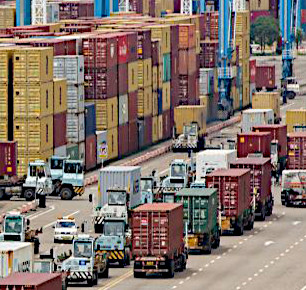Interprovincial Trade Barriers – A Solution Looking for a Problem?
Canada struggles with the threats from the United States that include imposing not only high tariffs, but even the unimaginable – annexing the country. In a highly defensive mode, the economic future of the country is beginning to be debated.
Ontario Premier Doug Ford, calls for tighter US trade ties, as do others such as Claude Lavoi, who was recently in charge of policy analysis at the Department of Finance, on the side supporting an economic union with the US.
The more constructive and immediate approach is do things that would make Canada less dependent on the US. The US and Canadian economies are highly inter-dependent, but Canada is more vulnerable because about 33% of the national income is reliant on exports, mostly to the US, while the US is only about 11% export dependent and not primarily to Canada.
Many Canadian business leaders, trade unions leaders and politicians are calling for a new ‘industrial policy,’ that would focus on finding more reliable trading partners, intensifying resource extraction and electric car production, and bolstering areas where Canada could be more self-sufficient. However an industrial policy involves significant government planning and funding over a long period of time. Its direction will be highly debated because priorities will be very different for corporations than for people.
In the meanwhile, the immediate response to Trump’s threats is an almost total buy-in from all over the country to pursue what is purported to be the low-hanging fruit of removing barriers to interprovincial trade. It seems reasonable because it is something Canada could do on its own fairly quickly, and it is assumed it would rid the country of the inefficiencies that results from the plethora of regulations that provinces erect to pursue provincial interests.

Are Interprovincial Regulations a Problem?
The federal government and most provinces agree interprovincial trade barriers are a drag on the economy. Most recently Anita Anand signaled that the federal government plans to reduce barriers to trade by eliminating at least half of the federal ‘exceptions’ to the Canada Free Trade Agreement (CFTA).
CFTA came into effect in 2017, having been built on the 1995 Agreement on Internal Trade. It is primarily a cooperative approach to standardizing some issues in a federation. These agreements do not over-ride constitutional obligations. The main difference with CFTA over the 1995 agreement is that it covers almost the entire economy, including most of the service sector (about 70% of the national income), and for the first time, the energy sector (about 9% of the national income).
The objective of CFTA has been to resolve what are considered to be regulatory barriers but, at the same time, allow governments to adopt and apply their own laws and regulations to achieve their own policy objectives. Each province could carve out areas to maintain its own rules. In addition, there are thirteen significant “exceptions” that apply across the entire country. These exceptions protect some areas from challenges and deal with issues such as language rights, aboriginal people, taxation, social services, and water.
Examples of the types of carve-outs provinces have listed are the following: to protect provincial electricity systems and alcohol monopolies, to require a provincial presence for providing real estate services, to allow the province control over issues related to farmland, and to maintain social services.
The usual arguments used to remove the provincial “exceptions” are that it’s easier to trade with the US than between Canadian provinces and that these regulatory barriers impose enormous costs on the Canadian economy.
The high estimates of the economic costs are based on problematic sources, including the mostly frequently cited IMF working paper on Canada’s interprovincial trade. It says provincial barriers cost about 4% per capita per year. Deloitt’s, in a paper for the interprovincial working group on interprovincial trade in 2021, using the same IMF paper, estimates a 3% increase to real GDP amounting to about $80-billion a year if barriers are eliminated.
These estimates are ratchetting up. In January 2025, Anita Anand, Minister of Transport and Internal Trade, cited estimates from the work of the Federal Committee on Internal Trade. It claims eliminating interprovincial trade barriers will lower prices by up to 15%, boost productivity up to 7%, and add as much as $200-billion a year to the economy. These estimates are huge and dramatic increases over previous estimates. They are likely to make a big impression on premiers as they negotiate reducing provincial regulations. However, these claims need far more scrutiny than they are currently receiving.
It is highly unlikely that eliminating the regulations that business views as trade barriers, will result in large interprovincial increases in trade, improved productivity, or the claimed savings.
The Big Transportation Costs
Important information on this comes from a recent report from Statistics Canada, the Canadian Survey on Interprovincial Trade. This survey examines the obstacles Canadian businesses encounter in interprovincial trade and why some businesses choose not to engage in it at all. The findings should be an important revelation to politicians expecting enormous gains from eliminating many provincial regulations.
According to the Statistics Canada report, the following are concerns related to interprovincial trade:
- The greatest obstacle is the cost of transportation for both businesses purchasing (27.4%) and selling (23.2%) goods or services.
- Businesses in the territories were the most likely to have purchased goods or services from another province or territory, led by businesses in Nunavut (77.0%). Conversely, businesses in Ontario (34.4%) and Quebec (33.3%) were the least likely to have purchased goods or services interprovincially.
- The share of businesses selling goods or services to another province or territory ranged from 31.9% in Alberta to 12.6% in Nunavut.
- Comparison with international trade shows that 30.2% of businesses purchased goods or services from international suppliers and 14.5% sold goods or services to international customers.
- Most businesses who did not purchase (89.5%) or sell (88.2%) goods or services across provincial or territorial borders cited no need or interest in doing so.

The take-away from this is that the main reasons businesses do not have more interprovincial trade is primarily because of the structure of the Canadian economy and its geography. The provinces and territories, like Nunavut and New Brunswick, which have little in the way of manufacturing, tend to import more from Ontario and Quebec, while the provinces with the most manufacturing, Ontario and Quebec, are the least likely to purchase interprovincially. But there is more business trade between provinces than there is with the US. Mostly those businesses that find significant barriers to trade cite issues related to geography – mainly the cost of transportation.
As provinces and the federal government discuss proposals to remove ‘obstacles’ to trade, serious focus needs to be on the costs of removing what some businesses consider barriers and determining whether these are true impediments to trade.
In many cases, they will focus on removal of crucial regulations that either protect people or allow provincial governments to promote their own economic and social policy objectives. Removing the policy tools of government undermines democratic control and makes it much harder to counteract the negative impacts of what Trump is now doing.
The major approach now being touted to lower the ‘barriers’ to interprovincial trade is the mutual recognition of regulations between the provinces. This means, in effect, that the least stringent regulation would likely become the national standard. This is something the corporate sector has long pursued, and something that could easily be achieved now, if the rush to do something in the face of an existential threat goes ahead without consideration of what the true cost will be. •





